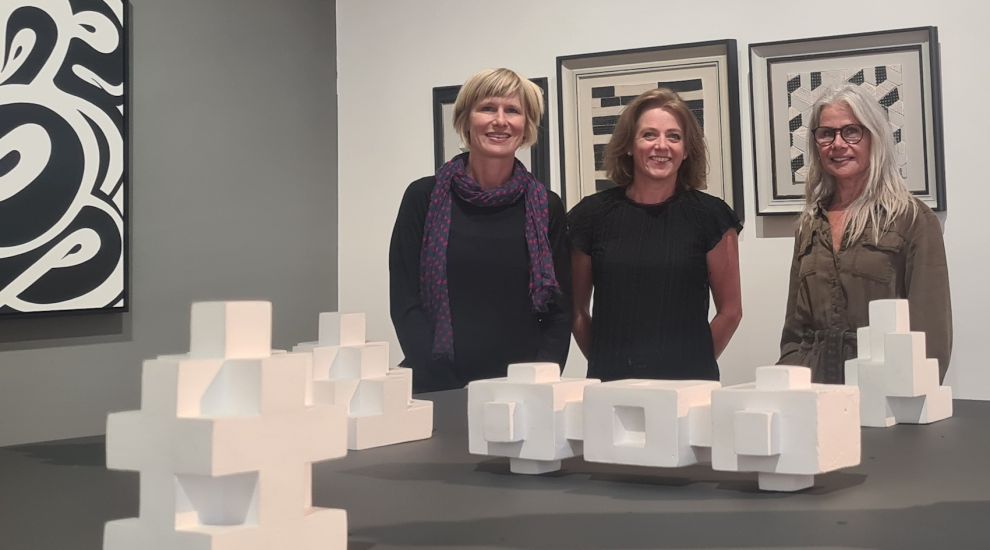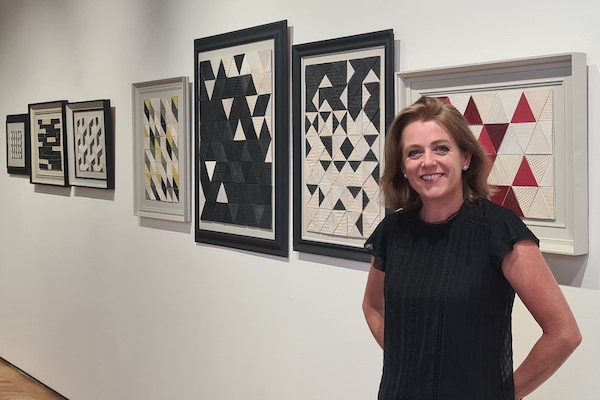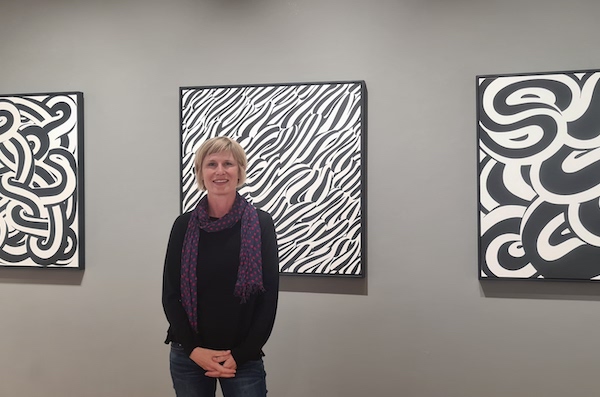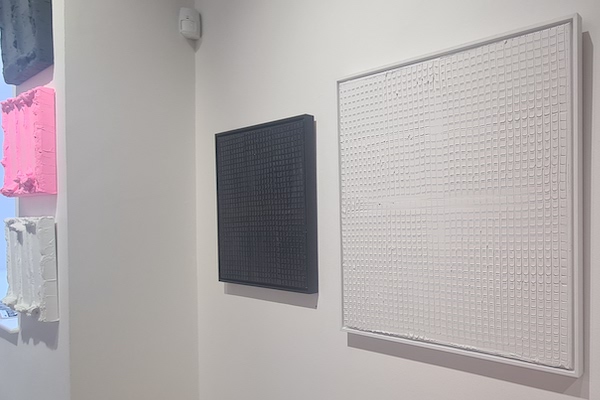


From Lego wheels to psychology, Jersey granite, eastern philosophy and hair combs…the inspirations that have shaped a new geometry-themed exhibition are extremely varied.
Claire Haithwaite, Nina Zaech and Nicole Smith are exhibiting their latest work at Private and Public until 15 October.
The show also features a variety of paintings, prints, sculptures and ceramics by artists such as Bridget Riley, Richard Allen, Victor Pasmore, Sir Terry Frost and Patrick Heron, all of whom have expressed their creativity through the use of geometry.
Video: A virtual tour of Geometrica.
Express spoke to Claire, Nina and Nicole to discuss the inspiration for their work and where their interest in shapes and curves came from...
After studying Art and Design at Kingston and then a BA in Graphics at Falmouth Art College in Cornwall, Claire moved to London to pursue a career in design, publishing and retail design.

Pictured: In addition to her pottery-making business, she now creates ceramic panels designed with her graphics background.
Eventually she moved to Amsterdam where she worked in a Dutch design company.
After 25 years away from Jersey, she returned to the island with her family and began studying ceramics.
In addition to her pottery-making business, she now creates ceramic panels designed with her graphics background, using different textures in the clay and glazes to make minimal abstract art, a series of which are on display at Private and Public.
I am a ceramic artist. I make graphic ceramic panels with stoneware clay, these panels are made up of smaller, individual tiles to make one large piece, they are made and designed to fit into beautiful vintage frames.
Beautiful interiors, textures and shapes.
View this post on Instagram
Pictured: Claire makes makes graphic ceramic panels with stoneware clay.
I am constantly on the lookout for new textures, everything from the treads of Lego wheels to Jersey granite and hair combs! My favourite medium is, of course, clay!
To me simplicity and order is key. I used to do abstract patchwork quilts from vintage fabrics, so maybe this is the crossover from my textiles to ceramics.
I only discovered ceramics four years ago, it must be the natural progression.
Nina’s way into art, she says, was “full of curves”.

Pictured: Nina "plunged into art" just over three years ago.
Having grown up in a very artistic family in Switzerland, she decided it was best to study psychology and economy first. After a series of jobs including HR Consultant, Hospitality Manager in a hospice and Hotel Manager in the mountains, she moved to Jersey in 2015 and founded a family.
“I felt that it was the right time to be brave and plunge into art,” she said.
I do many small sketches, mostly when my family is around, and only with a few of them I have suddenly this special feeling of harmony and flow. I transfer them later to a large canvas or lino or paper, which medium I choose depends totally on a feeling.
Sometimes painting seems to be the best for what I want, sometimes linoprint gives the idea the right touch. But of course, there are so many techniques and styles which I don't know yet and want to discover. I am an autodidact; so everything takes a bit more time, but I love learning and discovering and I will never stop doing that.
I have always had a fascination for optical art, I studied psychology, including perception psychology. I have a good spatial sense and I like to play with it in my head.
At college, I would constantly draw patterns and geometric worlds into my notebooks. I found it even helped me listen to the teacher. My works are inevitably based on geometric rules, but I don't expect them to be mathematically perfect. I don't calculate anything.
View this post on Instagram
Pictured: Nina at work in her studio.
For me, it’s important that I feel the curves which come out of my hand and that my eye enjoys following them. Because I mostly draw an undefined mass, I have total freedom in how to design it.
Stripes and lines want to show extension and compression, which is even a physical element in addition to the geometric one.
Sometimes, while painting, it also reminds me of the human body, the folding and falling of flesh. It becomes something sensual, without an initial goal to do so.
I am fascinated by how lines can define an object or a landscape, and change it, and how a few optical elements can create an object.
In the last three years, since I started doing art, I’ve had projects with totally different subjects and my inspiration came from all sorts of sources: my little animation movie was inspired by a social subject, my mountain paintings were inspired by my memories of the place I grew up in, my geometric works are inspired by many things; and last, but not least, my parents.
I grew up with my mother doing ceramics for a living, there were always ceramics and sculptural work around me. She used one ton of clay per year, and I helped her carry the clay bags to her workshop, and sometimes I did my own creations. My father, whom I visited regularly, is an object artist, doing graphic and minimalistic art. I loved his atelier, all his drawing material, and I remember he was often drawing little things for me and my brother, and I tried to copy them.
Nicole’s creative journey began at an early age.

Pictured: As a relatively shy child, Nicole says she realised art was the best form of self-expression.
As a relatively shy child, she said she realised art was the best form of self-expression. Even after an Art degree and a win at the JJ Fox competition under her belt, she still approaches art in the same way.
"My motivation for painting starts with something that emotionally resonates within me at the time," she says.
My work is a way of communicating feelings, thoughts and observations. My recent direction has been influenced by the pandemic, which for all of us was a time of self reflection.
As a result, I wanted to focus on achieving pure expression by pulling away from many ideological and complex things.
View this post on Instagram
Pictured: A close-up of one of Nicole's impastos.
I don’t name my works, they have their own expression. My intention is to produce calm, meditative paintings that make you want to look beyond.
More recently, I’ve been looking at eastern philosophies and Dansaekhwa, a 70s South Korean movement.
Currently in the exhibition I have four interrelated but distinct styles of work which all share the Dansaekhwa principles of singular colour and repetitive brush strokes.
As time has progressed, my work’s become more textural - sitting somewhere between painting and sculpture.

Pictured: "My intention is to produce calm, meditative paintings that make you want to look beyond," Nicole said.
I make my own concrete/polymer mix to which I add pigments. A little alchemy is involved and this can be a temperamental medium but results in unique pieces.
My research into Dansaekhwa led me towards repeated patterns and geometrics. Geometric abstractions result from repeated raking or manipulation of the medium. Thick textural forms, ripples and organic shapes produce seemingly ordered patterns, reflecting the beauty in all things imperfect, impermanent and incomplete.
Comments
Comments on this story express the views of the commentator only, not Bailiwick Publishing. We are unable to guarantee the accuracy of any of those comments.